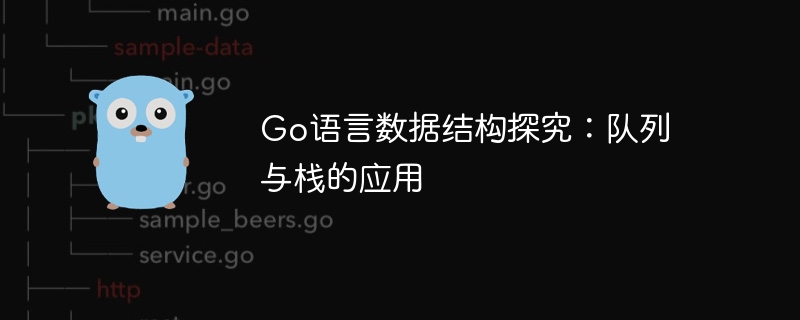Home >Backend Development >Golang >Research on Go language data structure: application of queue and stack
Research on Go language data structure: application of queue and stack
- PHPzOriginal
- 2024-04-08 12:57:01951browse
In the Go language, the queue follows the first-in-first-out (FIFO) principle and is implemented using the list package in the standard library. It is often used in messaging systems; the stack follows the last-in-first-out (LIFO) principle and is often used for function call tracking and bracket matching. , which can be implemented using slices.

Go language data structure talk: application of queue and stack
Queue
Queue is a data structure that adheres to the first-in-first-out (FIFO) principle. This means that the earliest elements entered into the queue will be removed first. Queues are useful in the following scenarios:
- Message delivery systems, such as message queues
- Buffers, such as network request queues
Go Implementation of queues in the language
The most common way to implement queues in the Go language is to use container/liststandard library package:
import (
"container/list"
)
// 定义队列类型
type Queue struct {
items *list.List
}
// 创建队列
func NewQueue() *Queue {
return &Queue{
items: list.New(),
}
}
// 进队
func (q *Queue) Enqueue(item interface{}) {
q.items.PushBack(item)
}
// 出队
func (q *Queue) Dequeue() interface{} {
if q.IsEmpty() {
return nil
}
front := q.items.Front()
q.items.Remove(front)
return front.Value
}
// 判断队列是否为空
func (q *Queue) IsEmpty() bool {
return q.items.Len() == 0
}Practical combat Case: Message Queue
Message queue is a typical application scenario of queue. We can use the queue in the Go language to implement a message queue:
func main() {
// 创建消息队列
queue := NewQueue()
// 向队列发送消息
queue.Enqueue("消息 1")
queue.Enqueue("消息 2")
// 接收消息
for {
msg := queue.Dequeue()
if msg == nil {
break
}
fmt.Println(msg)
}
}Stack
The stack is a data structure that adheres to the last-in-first-out (LIFO) principle. This means that the last element added to the stack will be removed first. The stack is very useful in the following scenarios:
- Function call tracing
- Bracket matching
Implementation of stack in Go language
The simplest way to implement the stack in the Go language is to use slicing:
// 定义栈类型
type Stack []interface{}
// 进栈
func (s *Stack) Push(item interface{}) {
*s = append(*s, item)
}
// 出栈
func (s *Stack) Pop() interface{} {
if s.Empty() {
return nil
}
top := (*s)[len(*s)-1]
*s = (*s)[:len(*s)-1]
return top
}
// 判断栈是否为空
func (s *Stack) Empty() bool {
return len(*s) == 0
}Practical case: bracket matching
The stack is a checker for bracket matching Good tool:
func isBalanced(expr string) bool {
stack := Stack{}
for _, char := range expr {
if char == '(' || char == '[' || char == '{' {
stack.Push(char)
} else if char == ')' || char == ']' || char == '}' {
if stack.Empty() {
return false
}
top := stack.Pop()
if (char == ')' && top != '(') || (char == ']' && top != '[') || (char == '}' && top != '{') {
return false
}
}
}
return stack.Empty()
}The above is the detailed content of Research on Go language data structure: application of queue and stack. For more information, please follow other related articles on the PHP Chinese website!

